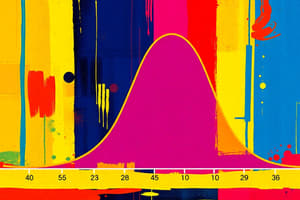Podcast
Questions and Answers
What is a key advantage of participant observation?
What is a key advantage of participant observation?
- Ability to predict behaviors accurately
- Better understanding of the group (correct)
- Less reliance on respondent willingness
- Strict control over variables
Which statement best describes non-participant observation?
Which statement best describes non-participant observation?
- The observer frequently intervenes during observation.
- The observer only observes in a controlled environment.
- The observer maintains objectivity and neutrality. (correct)
- The observer actively engages with the group.
How does controlled observation differ from uncontrolled observation?
How does controlled observation differ from uncontrolled observation?
- Controlled observation occurs under prearranged plans. (correct)
- Controlled observation is not influenced by laboratory settings.
- Controlled observation is spontaneous.
- Controlled observation is solely qualitative.
What characterizes a structured interview?
What characterizes a structured interview?
What type of interview focuses on the respondent’s specific experiences and their effects?
What type of interview focuses on the respondent’s specific experiences and their effects?
Which of the following is an advantage of uncontrolled observation?
Which of the following is an advantage of uncontrolled observation?
What is a primary characteristic of personal interviews?
What is a primary characteristic of personal interviews?
What is a disadvantage of participant observation?
What is a disadvantage of participant observation?
What is the main characteristic of probability sampling?
What is the main characteristic of probability sampling?
Which of the following is NOT a method of probability sampling?
Which of the following is NOT a method of probability sampling?
What does stratified sampling aim to achieve?
What does stratified sampling aim to achieve?
In which scenario would you most likely use stratified sampling?
In which scenario would you most likely use stratified sampling?
What is the fundamental principle behind simple random sampling?
What is the fundamental principle behind simple random sampling?
What is a key feature of cluster sampling?
What is a key feature of cluster sampling?
When using stratified sampling, how should the sample size be determined?
When using stratified sampling, how should the sample size be determined?
Which statement about probability sampling techniques is true?
Which statement about probability sampling techniques is true?
What is the primary focus of Descriptive Statistics?
What is the primary focus of Descriptive Statistics?
Which of the following defines a Population in statistical terms?
Which of the following defines a Population in statistical terms?
Why is increasing sample size mentioned as being of little help in analytic studies?
Why is increasing sample size mentioned as being of little help in analytic studies?
What does Inferential Statistics primarily deal with?
What does Inferential Statistics primarily deal with?
What type of data are classified as 'Ungrouped data'?
What type of data are classified as 'Ungrouped data'?
What is the essential purpose of statistics in research?
What is the essential purpose of statistics in research?
Which statement is true regarding statistical analysis methods like confidence intervals and significance levels in analytic studies?
Which statement is true regarding statistical analysis methods like confidence intervals and significance levels in analytic studies?
What is a Sample in statistical terms?
What is a Sample in statistical terms?
What is the mode of the set of numbers 3, 3, 5, 7, 9, 10, 11, 10, 11, 12, 9, 18, 9?
What is the mode of the set of numbers 3, 3, 5, 7, 9, 10, 11, 10, 11, 12, 9, 18, 9?
Which statement accurately describes the mode of the second example set 2.2, 3.1, 4.1, 4.1, 5.4, 5.4, 5.4, 5.4, 6.2, 7.7, 7.7, 8.5, 8.5, 8.5, 9.3?
Which statement accurately describes the mode of the second example set 2.2, 3.1, 4.1, 4.1, 5.4, 5.4, 5.4, 5.4, 6.2, 7.7, 7.7, 8.5, 8.5, 8.5, 9.3?
In the formula provided for calculating mode of grouped data, what does 𝐿𝑚𝑜 represent?
In the formula provided for calculating mode of grouped data, what does 𝐿𝑚𝑜 represent?
What does the variable $d_1$ signify in the mode formula for grouped data?
What does the variable $d_1$ signify in the mode formula for grouped data?
If the frequencies of the modal class and the class before it are 4 and 2 respectively, what would be the value of $d_2$ if the frequency of the class after the modal class is 0?
If the frequencies of the modal class and the class before it are 4 and 2 respectively, what would be the value of $d_2$ if the frequency of the class after the modal class is 0?
How is the mode calculated for the grouped data classes if the lower boundary of the modal class is 109.5, the size of the modal class is 10, and the calculated differences are 4 and 0?
How is the mode calculated for the grouped data classes if the lower boundary of the modal class is 109.5, the size of the modal class is 10, and the calculated differences are 4 and 0?
In the example provided, which class has the highest frequency?
In the example provided, which class has the highest frequency?
What is the mode of the classes: 80-89 (2), 90-99 (3), and 110-119 (4)?
What is the mode of the classes: 80-89 (2), 90-99 (3), and 110-119 (4)?
What is the formula used to calculate the mean of grouped data?
What is the formula used to calculate the mean of grouped data?
In the context of a frequency table, what do the symbols $f_i$ and $x_i$ represent?
In the context of a frequency table, what do the symbols $f_i$ and $x_i$ represent?
If there are 30 observations in a dataset and the total of the products of frequencies and class marks is 44.81, what is the mean of the grouped data?
If there are 30 observations in a dataset and the total of the products of frequencies and class marks is 44.81, what is the mean of the grouped data?
When calculating the mean of grouped data, which of the following is an incorrect assumption?
When calculating the mean of grouped data, which of the following is an incorrect assumption?
How many observations are represented in the example provided for calculating the mean?
How many observations are represented in the example provided for calculating the mean?
Flashcards are hidden until you start studying
Study Notes
Analytic Studies and Statistics
- Confidence intervals, significance levels, and analysis of variance may lack rational basis in analytic studies.
- Increasing sample size can be expensive and offers limited benefits.
Definition of Statistics
- Statistics involves the collection, organization, presentation, analysis, and interpretation of data.
- Divided into two main branches: Descriptive Statistics and Inferential Statistics.
Descriptive Statistics
- Aims to organize, summarize, and describe quantitative data.
- Focuses solely on describing and analyzing existing data without making predictions.
Inferential Statistics
- Involves making conclusions or judgments about a population based on sample data.
- Utilizes samples to infer characteristics about larger populations.
Key Statistical Terms
- Population or Universe: The complete set of objects, individuals, or items in a study.
- Sample: A subset taken from a population for analysis.
- Data: Information collected, which can be qualitative or quantitative.
- Ungrouped (or raw) data: Data not organized systematically.
Types of Observation
- Participant Observation: Observer is part of the group being studied.
- Advantages include natural behavior observation and deeper understanding.
- Non-participant Observation: Observer remains separate; promotes objectivity.
- Advantages include neutrality and increased willingness from respondents.
Methods of Data Collection
- Primary Data: Directly collected information through various methods.
- Types of Observation:
- Controlled: Observation under natural conditions for spontaneous insight.
- Uncontrolled: Observations with predetermined plans, typically in labs.
Interview Method
- Involves verbal communication between interviewer and respondent to gather information.
- Types of interviews include:
- Personal Interviews: Face-to-face engagement with participants.
- Structured Interviews: Employ pre-defined questions.
- Unstructured Interviews: Flexible questioning, no predetermined format.
- Focused Interviews: Concentrate on specific experiences of respondents.
Mean and Mode of Grouped Data
- Mean Calculation: Sum of products of class marks and frequencies divided by total frequency.
- Mode Calculation:
- Mode can be unimodal (single mode) or bimodal (multiple modes).
- Mode formula: ( \text{Mode} = L_m + \left( \frac{d_1}{(d_1 + d_2)} \times C \right) ) where ( L_m ) is the lower boundary of the modal class.
Probability Sampling
- Ensures that each population member has an equal chance of being selected in a sample.
- Types of Probability Sampling:
- Simple Random Sampling: Selection purely by chance.
- Stratified Sampling: Accounts for population sub-groups (strata) to ensure representation.
- Samples drawn must reflect the proportions of each stratum in the overall population.
Studying That Suits You
Use AI to generate personalized quizzes and flashcards to suit your learning preferences.




